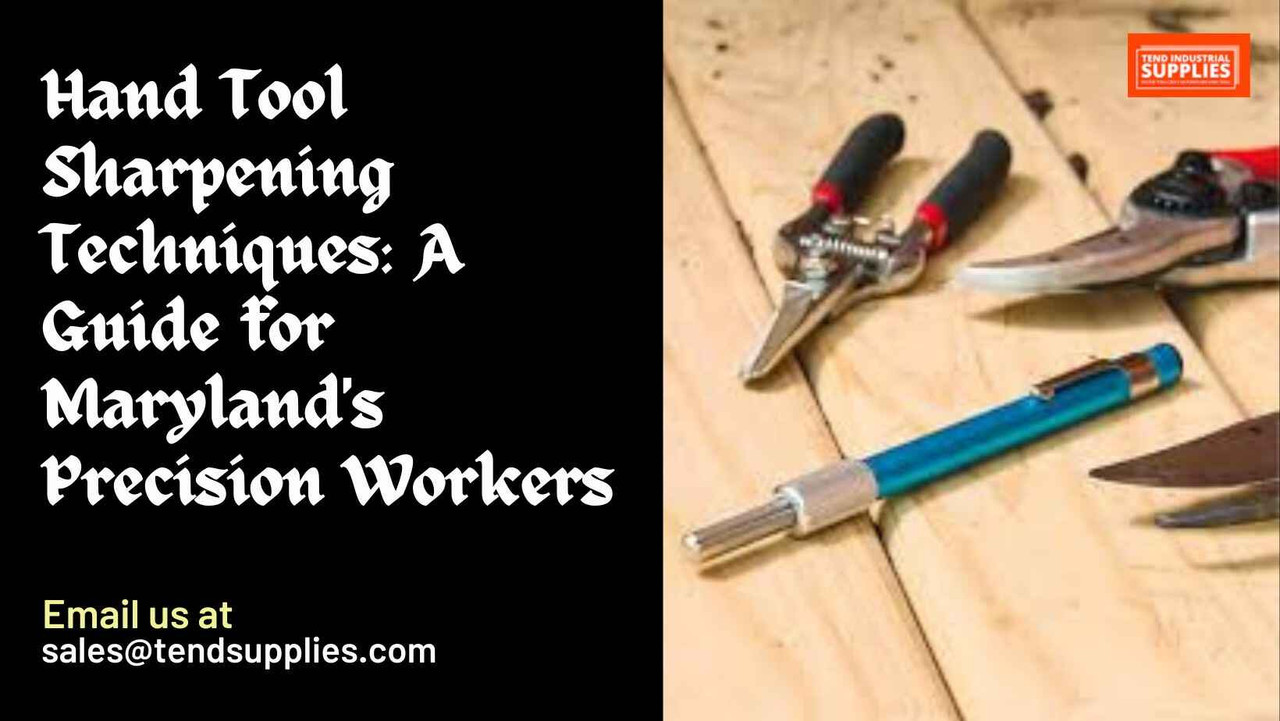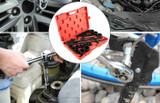Hand Tool Sharpening Techniques: A Guide for Maryland's Precision Workers
Introduction
In precision work, the sharpness of your hand tools makes all the difference. For Maryland’s craftsmen and technicians, tools like chisels, plane irons, and saw blades are essentials, and keeping them sharp is critical for safety, performance, and efficiency.
This guide will take you through key sharpening techniques suited to Maryland’s unique climate and provide insights into the best practices and tools to help maintain peak tool performance.
Learn more: Ultimate Guide to Choosing Hand Tools for Specific Industries in Maryland
Understanding Tool Sharpening Basics
Why Sharp Tools Matter
Sharp tools offer more than just a clean cut. They reduce the physical effort required, minimize strain, and improve control and accuracy. Furthermore, dull tools can be hazardous, as they require more force and are more prone to slipping, which increases the risk of accidents. Regular sharpening also extends the lifespan of your tools by preventing wear from misuse.
Key Concepts in Tool Sharpening
- Angle and Bevel: The angle at which a tool is sharpened determines its sharpness and durability. For most hand tools, sharpening angles range from 20 to 30 degrees, depending on the tool’s function.
- Burr Formation: A burr is the small edge that appears during sharpening; removing this is essential for a refined, clean edge.
- Grit Levels: Coarse grits (80-200) are for reshaping, medium grits (300-600) refine the edge, and fine grits (1000-8000) polish and finish the blade.
- Essential Tools and Materials for Sharpening
1. Types of Sharpening Stones
- Oil Stones: Known for durability, oil stones offer a slower cut and are typically used for coarse sharpening.
- Water Stones: These stones provide faster sharpening but require more maintenance, as they need to be soaked before use.
- Diamond Stones: Known for longevity and fast cutting action, diamond stones work on harder metals and require minimal maintenance.
2. Honing Guides and Jigs
Honing guides are crucial for maintaining a consistent angle when sharpening, especially for beginners. Jigs allow you to set the desired sharpening angle, ensuring precision, which is especially useful for tools requiring specific angles like chisels and plane irons.
3. Lubricants
Using oil or water on your stones prevents clogging, keeping them effective longer. It also helps to create a smoother sharpening surface, essential for finer grits. Ensure you match the lubricant to the stone type—use oil for oil stones and water for water stones.
4. Strops and Compounds
For the final polish, strops and compounds are applied to the tool’s edge after sharpening, enhancing sharpness by removing any remaining burrs and refining the edge to a razor-like finish.
Step-by-Step Sharpening Techniques for Common Tools
1. Chisels and Plane Irons
- Preparation: Start by selecting a coarse grit to remove any nicks in the edge.
- Sharpening: Move to medium and fine grits for refining. Maintaining a consistent angle is key.
- Honing: Use a honing guide and a strop to achieve a polished, sharp edge, perfect for woodworking.
2. Knives and Carving Tools
- Angle Selection: Set the angle according to the tool’s intended use, typically between 15-20 degrees for carving knives.
- Refinement: Progress through the grit levels to ensure a clean and sharp edge.
- Polishing: Use a strop and compound for a smooth finish, which is especially important for detailed carving work.
3. Saws and Serrated Tools
- Manual Sharpening: For hand saws, use specialty files designed for saw teeth.
- Technique: Work slowly and carefully to maintain each tooth’s angle, ensuring even sharpness.
4. Specialty Tools (e.g., Gouges, Adzes)
- Understanding Bevel Types: Gouges often have curved edges, requiring rotational sharpening techniques.
- Tools and Accessories: Small honing stones or specialty sharpeners are ideal for these tools, allowing you to work with precision on the rounded edges.
Preventative Maintenance and Regional Tips
1. Storing Tools in Maryland’s Climate
Maryland’s humidity poses a challenge for tool storage, as moisture can lead to rust. Store tools in a cool, dry place and consider adding silica gel packets or rust inhibitors to tool storage boxes. For high-value tools, moisture-resistant tool chests are an excellent option.
2. Regular Maintenance Routines
Routine maintenance keeps tools in top shape. Regularly hone blades after every few uses, and perform full sharpening only when necessary. Consistent honing helps to prolong the time between full sharpening sessions.
3. Using Rust Prevention Products
Rust-preventive oils and coatings are essential for tools used in Maryland’s humid conditions. Products like machine oil or WD-40 can help prevent rust, and applying them after each use is a quick and effective way to keep tools rust-free.
Advanced Sharpening Techniques for Professionals
1. Precision Sharpening with Honing Jigs and Digital Angle Finders
For Maryland’s precision workers, advanced sharpening jigs and digital angle finders provide an unmatched level of accuracy. By setting exact angles, these tools help create consistent bevels and allow users to achieve professional-grade sharpness, critical in precision woodworking, cabinetry, and other skilled trades.
2. Micro-Beveling for Enhanced Edge Durability
Micro-beveling involves creating a secondary, steeper angle along the blade’s edge, strengthening it while maintaining sharpness. This technique is especially beneficial for tools that undergo heavy use, such as chisels and plane irons, as it reduces wear and prolongs the edge’s life.
3. Sharpening Unconventional Tools
Tools like scythes, adzes, or curved gouges require specialized techniques and equipment. Using custom-shaped honing stones, sandpapers, or handheld sharpeners allows for intricate work on these less common tools. Maryland’s craftsmen who rely on diverse tools for unique projects benefit from mastering these advanced techniques.
Safety Considerations During Sharpening
1. Proper Hand and Eye Protection
Using sharpening tools requires sharp focus and caution. Wearing safety gloves can provide an extra layer of protection when handling sharp tools, while safety glasses are essential to prevent small metal particles or grit from getting into your eyes.
2. Stabilizing Tools During Sharpening
For safety, always stabilize the tool you're sharpening to avoid slips. Bench vises and clamps can secure larger tools, preventing movement and reducing the risk of accidents.
3. Maintaining Sharp Tools Safely
Handling sharpened tools requires a different level of care. Use blade guards, and always store tools in a way that minimizes contact with the sharpened edges. Safe storage practices prevent accidental cuts and keep tools protected.
Recommended Tool Sharpening Products for Maryland Precision Workers
1. Top Sharpening Stones and Honing Guides
- Diamond Stones: Known for durability, precision, and minimal maintenance. Excellent for professionals seeking efficiency.
- Water Stones: Provide a quicker sharpening experience with finer control; ideal for finishing.
- Honing Guides: For maintaining consistent angles, an essential tool for professionals and beginners alike.
2. Rust-Prevention Solutions
- Protective Coatings: Products like anti-corrosive sprays and rust-preventive oils keep tools in prime condition, especially valuable in humid environments.
- Desiccant Packs and Moisture Absorbers: Effective for toolboxes and storage areas to minimize humidity exposure.
3. Portable Sharpeners
- For on-site work, portable sharpeners are convenient and allow for quick edge maintenance on job sites. Look for options compatible with multiple tool types for versatility.
Frequently Asked Questions
1. What is the best angle for sharpening chisels?
Chisels are typically sharpened at an angle between 25 and 30 degrees. For general woodworking, 25 degrees is common, while 30 degrees adds durability for heavy-duty applications.
2. How often should I sharpen my tools?
It depends on usage. Routine honing after each use helps maintain the edge, while full sharpening may be needed only a few times a year.
3. Can I use a sharpening stone on serrated tools?
Yes, but you’ll need a specialized sharpening tool for serrated edges, like a ceramic rod or small-diameter sharpening stone, to reach each serration.
4. What’s the difference between honing and sharpening?
Honing refines the edge without removing much material, extending the sharpness between full sharpenings, which involves reshaping the bevel and edge.
5. What’s the best way to prevent rust on tools in a humid area like Maryland?
Regularly applying rust-preventive oil and storing tools in a dry environment are key. Adding moisture absorbers to tool chests can also be effective.
Related Article
Regional Guide to Professional-Grade Hand Tools: Mid-Atlantic Industry Solutions
Japanese vs. German Hand Tools: The Ultimate Quality and Value Showdown
Conclusion
For Maryland’s precision workers, having the right tools and products can make all the difference in sharpening and maintaining your hand tools. At Tend Industrial Supplies, we provide premium sharpening equipment, rust prevention products, and expert advice on tool maintenance. Visit our website to explore our extensive collection designed to support the needs of professionals and DIY enthusiasts alike. Equip yourself with the best to ensure precision and longevity in every project.






